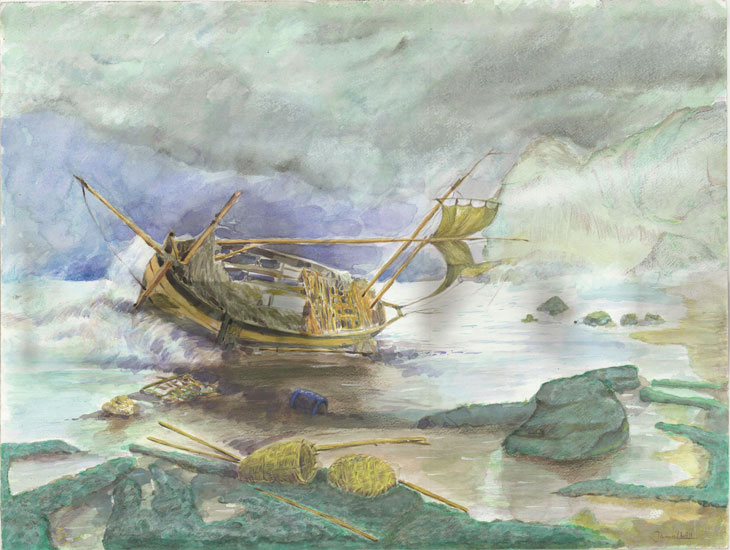An exhibition of art made by detainees from Guantánamo Bay in Cuba, on show in New York after years of prohibition and prevarication, shines a spotlight on the issue of art by those in captivity. ‘Ode to the Sea’ features 36 wholly unthreatening images from eight current and former inmates of the United States military prison, richly evocative of the ocean so close and yet largely invisible and unattainable to them while in captivity: a potent symbol of freedom and a link with the outside world. But the Pentagon, rattled by the attention this small show in Manhattan has provoked, has decreed that no future art from Guantánamo, declared ‘property of the US government’, will be seen by the public: the artists’ voices have effectively been drowned.
Untitled (Hands Holding Flowers through Bars) (2016), Muhammad Ansi. On view in ‘Ode to the Sea’ at President’s Gallery, John Jay College of Criminal Justice, New York. Courtesy the artist and John Jay College
There is no equivalent in the US or indeed anywhere else in the world of the Koestler Trust (of which I am vice chair of the board of trustees), which works in the UK with prisons, refugee detention centres and secure hospitals to encourage and exhibit artworks by inmates, who would otherwise have no voice in the wider world. The Trust was established in 1962 by Arthur Koestler, author of tale of captivity under Stalin Darkness at Noon, who had experienced captivity as a political prisoner no fewer than three times. While on death row in Franco’s Spain he had not even a pencil with which to scratch on the walls of his cell – he later described this deprivation of any means of self-expression as ‘the death of the soul’. He persuaded Rab Butler, then Home Secretary, and the prison service to trial a competition for serving offenders to produce writing or fine art which would be judged and duly rewarded; calling on distinguished friends, he included Kenneth Clark, Laurie Lee and V.S. Pritchett among the early judges.
Those were small beginnings; 57 years on the Koestler Trust receives more than 7,000 submissions a year in 50 different artforms, stages exhibitions of this work across the UK, and mentors ex-offenders to put their creative talents to use in finding a job or career. It is still supported by leading cultural figures, who are invited to guest-curate an annual exhibition at London’s Southbank Centre: in 2017 Antony Gormley curated ‘Inside’, following Benjamin Zephaniah’s ‘We Are All Human’ the previous year. In encouraging detainees to be creative, boosting their skills and self-esteem and giving them positive goals, these exhibitions also challenge the public’s often negative attitude. Visitors are astonished and deeply moved by the power and range of the work they see in Koestler shows, or the poetry they read in published anthologies. And by giving those ‘inside’ a voice ‘outside’, the Trust helps to mitigate the fear and suspicion that dog our social system; empathy can replace antagonism and enhance the possibility of change.
In Place of Hate (2017), Edmund Clark. Courtesy of the artist; Ikon and Flowers Gallery
Currently, a rich demonstration of art challenging boundaries is on display at the Ikon Gallery, Birmingham: Edmund Clark’s ‘In Place of Hate’, the culmination of a three-year residency at Europe’s only wholly therapeutic prison, HMP Grendon. Juxtaposing bleak images of Grendon’s 1960s architecture with giant close-ups of pressed plants, pinhole images of inmates mediated by their own interventions, and a film of inmates performing The Oresteia as an exercise in group catharsis, Clark offers a thoughtful meditation on how criminality is perceived by those within and without the system. He has worked, too, at Guantánamo Bay, and knows that how we treat our prisoners offers a profound, and valuable, insight into our society: they hold up a mirror, and challenge the humanity of us all.
